You want to be a regular exerciser but starting a new fitness routine is nerve-wracking. You are new to exercise or you have not exercised in a long time. But the fact is, you do not require large sums of money to join a fancy gym, a complex of machines, and hours of free time to begin.
The establishment of an everyday home exercise regimen — which you can perform daily on a regular basis — allows you to start building your way towards a stronger and healthier body. And it all starts with only a bit of space, determination, and the use of your bodyweight.
Whatever your intentions are — whether strength-building, more endurance, or just feeling good in your body — this guide will lead you through the daily plan of the workout that is perfectly suitable and friendly to beginners and that you can do at home. It doesn’t allow it to be about perfection. It is more of being present, exercising your body, and making an invulnerable habit.
Why a Home Workout Routine Matters for Beginners
Most people put off getting fit because they think they have to go to the gym. But here’s the truth: your best starting point is right at home. No commute, no crowds, no pressure to keep up with anyone else. You set the pace, listen to your body, and build confidence one step at a time.
Working out at home is perfect for beginners—it’s comfortable and private. You can wear whatever you want, play your favourite music, and take breaks without feeling self-conscious. Plus, it’s easy to fit in quick workouts whenever you have a moment, without worrying about gym hours or busy spaces.
Setting Realistic Fitness Goals Before You Begin
Before you jump into squats and lunges, it’s important to ask yourself—why are you doing this? Are you aiming to get leaner, boost your mobility, or just relieve some stress? Knowing your goal gives you a reason to keep going, especially on those days when staying in bed feels way more tempting than working out.
Once you have nailed down your goals, find simple ways to track your progress. You don’t need fancy gadgets—just write down how many reps you do, note how you feel after each workout, or snap a quick photo each week. These little habits help you see the changes before your eyes catch up!
What You Need to Start (Spoiler: Not Much)
The magic of bodyweight trainings is that actually, you do not require any equipment. Use a yoga mat, but, in case you do not have that, use whatever you have. Otherwise, a hand towel on the floor is ok too. Also make sure that the room is empty of furniture and clutter to allow you to move freely.
You may also like to have your water bottle, a clock (your phone will do), and an outfit that is comfortable to work out in. That’s it. No expectations, no hindrances.
The Best Time to Work Out Is Yours
Time is important as well. Others like doing exercise in the morning in order to have a good start to the day. Some prefer to release their stress by moving around in the evening. The optimal workout time is when there is a likelihood you will work out.
Warm-Up: The Five Minutes That Make a Difference
The Core Workout Structure: Full Body Basics
Here is where you have the main workout. In case you are a beginner, you should strive to have moves that exercise all the muscle groups 15 to 20 minutes a day. It is all about getting a balanced body — not individual parts such as abdominals or arms — but getting stronger overall.
| Time Block | Focus | Example Exercises |
|---|---|---|
| 0–5 min | Warm-up | Arm swings, shoulder rolls |
| 5–10 min | Lower body | Bodyweight squats, step-backs |
| 10–15 min | Upper body | Wall push-ups, arm circles |
| 15–20 min | Core & Cooldown | Plank hold, gentle stretches |
Begin at the point where you are comfortable to exercise at and start there. At the initial stages, it is not so much about quantity as about quality. Focus on control, good posture, and steady breathing. You can do 10 squats and feel that it is enough — it is all right. You will get stronger as time progresses.
Monday Through Sunday: What Should You Focus On?
As an example:
- Monday can be a full-body day.
- Tuesday, core moves like leg raises or glute bridges.
- Wednesday can focus on lower-body strength.
- Thursday takes the form of arms and posture.
- Friday, a quicker-paced routine that involves some cardio.
- Saturday is reserved for mobility and stretching.
- Sunday would be an active rest day.
Such an arrangement prevents your routine from becoming dull, and your body learns to tolerate various movements and levels of intensity.
Cooling Down and Stretching: The Forgotten Essential
When your muscles are burning and your heart is racing, it’s easy to think the workout ends there. But if you are new to exercising, the cooldown is just as important. It helps your heart rate come down gradually and can reduce post-workout soreness or dizziness.
Spend just 3–5 minutes walking in place, rolling your shoulders, and gently stretching the muscles you’ve worked. Focus on your breathing — it’s a simple way to reset, calm your body, and transition back into your day with ease.
Building a 7-Day Beginner Home Workout Calendar
Since you have decided to start sticking to a home workout routine and examined simple movements, it is time to combine everything into one structured weekly program. When you have a plan, it removes the guesswork on what to do every day — as you know what to do when you wake up and no reluctance to moving; no scrolling aimlessly on an app.
Here is a basic and practical 7-day workout schedule, especially meant to target the beginners. It aims to work every muscle group each week and strike the balance between pushing and recovering.
Weekly Beginner Home Workout
| Day | Focus | Routine Highlights |
|---|---|---|
| Monday | Full Body Basics | Squats, wall push-ups, glute bridges |
| Tuesday | Core + Balance | Planks, bird dog, seated leg lifts |
| Wednesday | Lower Body Strength | Lunges, step-ups (stairs), calf raises |
| Thursday | Upper Body Toning | Incline push-ups, arm pulses, triceps dips |
| Friday | Light Cardio | High knees, jumping jacks, side steps |
| Saturday | Mobility + Stretch | Shoulder rolls, yoga flow, hamstring stretch |
| Sunday | Active Rest | Gentle walk, breathing exercises, rest |
Every day, it requires only 20 to 25 minutes with warm-up and cool-down. If you are not feeling it, then lessen reps or time. You perform better showing up regularly rather than trying to perform so much and burning out.
How to Stay Motivated Without Equipment or a Trainer
One of the biggest challenges with working out at home—especially for beginners—is staying consistent when no one is watching. But with a few simple habits, you can build momentum and actually enjoy the process.
First, shift your mindset. Instead of thinking “I have to work out,” try “I get to move today.” This small change can turn exercise into a form of self-care, not a chore.
Treat your workouts like any other important appointment. Add them to your calendar or set a daily phone reminder. The more routine it feels—like brushing your teeth—the less you’ll fight it.
And don’t underestimate the power of tracking progress. Use a calendar, a habit tracker, or just stick a Post-it on your fridge. Each checkmark becomes a little win—and that growing streak? It gives your brain a hit of motivation to keep going.
Common Mistakes Beginners Make (and How to Avoid Them)
It’s completely normal to feel frustrated when workouts feel awkward or you don’t see results right away. But instead of giving up, it helps to know a few common mistakes that can slow progress — or even lead to injury.
1. Comparing yourself to others
Scrolling through fitness posts online can make you feel like you’re behind — but everyone starts somewhere. Your journey is yours. Progress matters more than perfection.
2. Skipping warm-ups and cool-downs
These aren’t optional. Warming up prepares your body to move, and cooling down helps you avoid soreness or feeling lightheaded afterward. They bookend your workout — don’t skip them.
3. Doing too much too soon
It’s tempting to go all in, thinking it’ll bring faster results. But pushing too hard too early can lead to burnout or injury. The real game-changer is consistency — not intensity.
How to Safely Progress Your Routine
As your body adapts, what once felt hard will start to feel easier. That’s your sign to level up — gently.
Here are a few simple ways to do that:
-
Add reps: If you started with 10 squats, go up to 12 next week, then 15, and so on.
-
Extend time: Hold that plank a little longer, or add a minute to your cardio session.
-
Combine movements: Try simple circuits like:
30 sec squats → 30 sec push-ups → 30 sec rest (repeat 2–3 rounds)
Just make sure your form stays solid. It’s better to do fewer reps correctly than push through with bad posture. If something feels off, scale back and rebuild the right way.
Fuelling Your Workout: The Importance of Nutrition and Hydration
Even the best home workout routine can fall flat if your eating habits don’t support it. You don’t need to obsess over counting every calorie, but being mindful of what you eat — especially around your workouts — can make a big difference.
Try to have a balanced meal about 60–90 minutes before you exercise. Think something simple like oatmeal with peanut butter or a bowl of Greek yogurt with fruit. After your workout, a light meal or snack with some protein will help your muscles recover and rebuild.
And don’t forget about hydration. Don’t just wait until you’re thirsty — keep a water bottle nearby while you exercise and sip throughout the day. Even mild dehydration can zap your energy and make moving feel harder than it should.
Summary | You’ve Already Begun
Chances are, you have already taken the first step towards getting fit — that’s the hardest part. Now, it’s about staying committed, showing up consistently, working mindfully, and being kind to your body as it grows stronger.
Your home workout routine doesn’t need to feel like a chore. Make it your own. Set aside time each day, stick to it, and watch how consistency builds your confidence.
Before long, this daily movement will be more than just exercise — it will be a powerful reminder that change is possible, and that you are absolutely worth it.
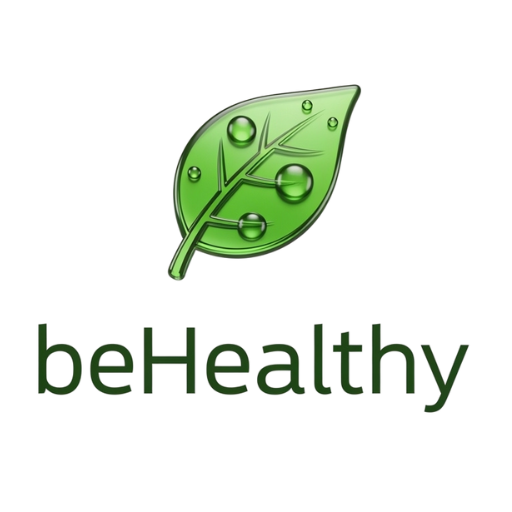
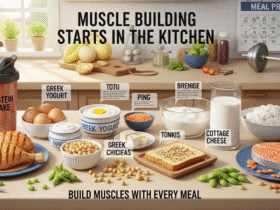



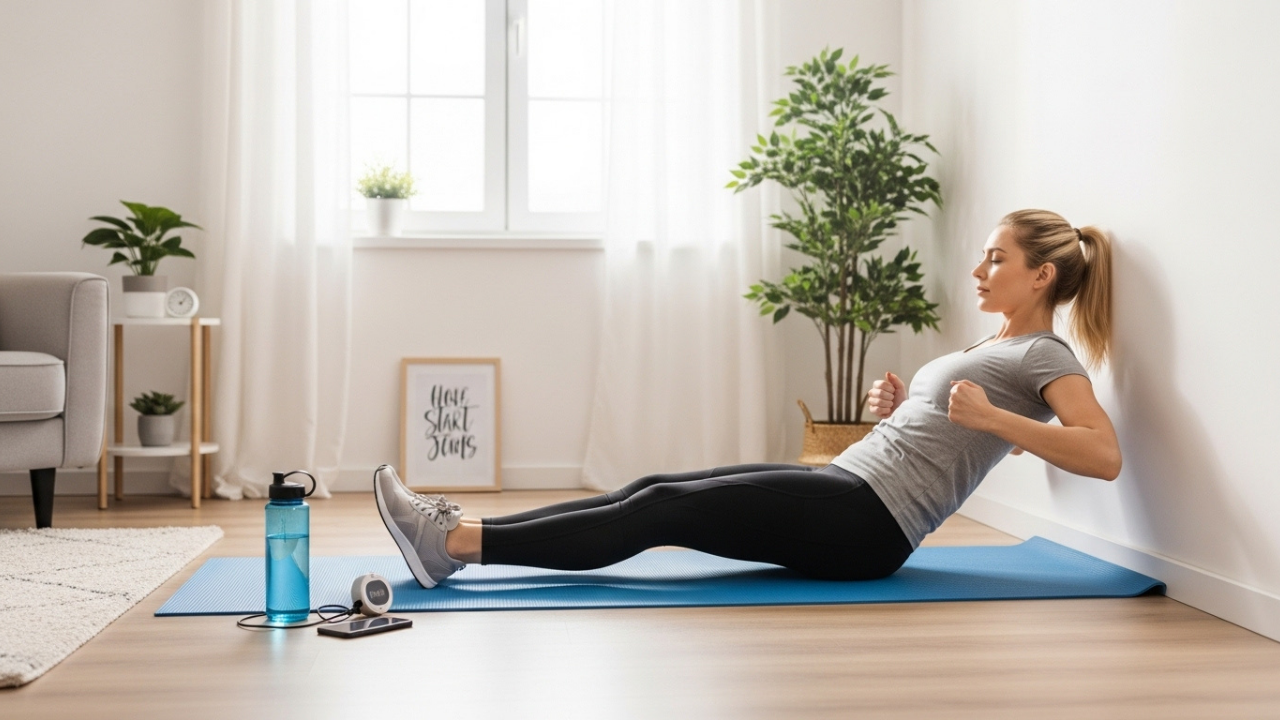
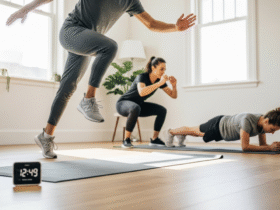



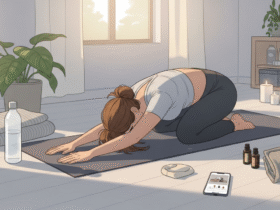
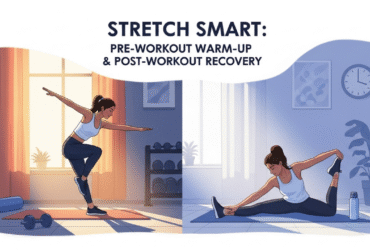
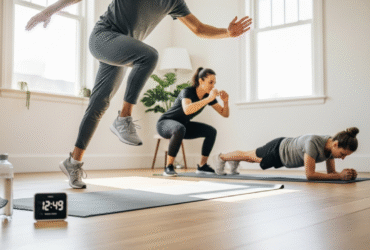
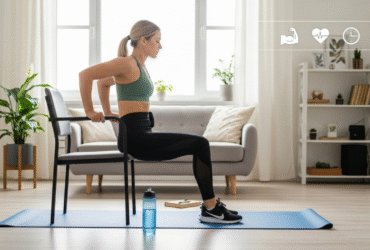
Leave a Reply